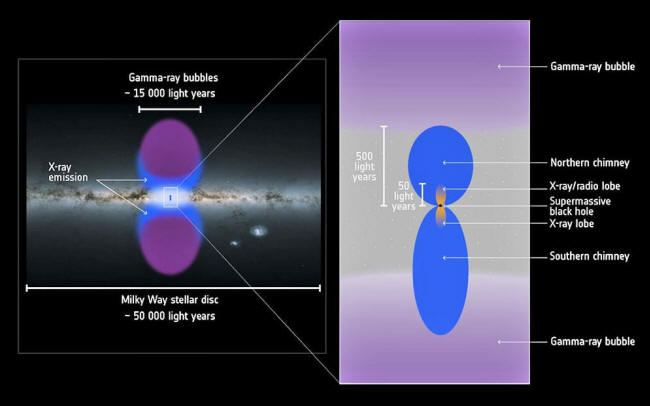|

by
A. Sutherland
March 26, 2019
from
MessageToEagle Website

An X-ray view
of the
centre of our Milky Way galaxy,
where
the supermassive black hole
Sagittarius A* is hosted.
ESA/XMM-Newton/G.
Ponti et al.
2019,
Nature.
source
In the Universe
there are many
gigantic objects and phenomena,
of which many we
still are unaware of.
Some of them
we've
already
discovered and observed.
An interesting recent discovery reveals two gigantic 'chimneys'
funneling hot X-ray matter flowing out from
Sagittarius A*, the Milky Way's supermassive
black hole, directly into two huge
cosmic bubbles.
First of the giant bubbles (both discovered in 2010 by NASA's
Fermi Gamma-ray Space Telescope),
extends over the plane of the Milky Way; the other below, forms a
huge hourglass that stretches for about 50,000 light years - about
half the diameter of the entire Galaxy.
The chimneys recently discovered by ESA's
XMM-Newton seem to link the
immediate surroundings of the black hole and the bubbles together.
Thanks to data delivered
by XMM-Newton satellite, researchers created the most extensive
X-ray map ever made of the Milky Way's core. Thus,
the chimneys, extending for
hundreds of light years, were also discovered.

This schematic images shows the scales of and the relationship
between the new-found chimneys and the already known “Fermi Bubbles”
and X-ray lobes at the centre (orange, in the panel to the right).
© ESA/XMM-Newton/G. Ponti et al. 2019
ESA/Gaia/DPAC (Milky Way map
CC BY-SA 3.0 IGOe
Source
Could these channels be exhaust pipes through which energy
and mass are transported from our Galaxy's heart out to the bubbles?
The outflow might be a remnant from our Galaxy's past, when activity
was far more powerful and extreme. Now, our galaxy is considered to
be 'quiescent' but as XMM-Newton has revealed our Galaxy's core is
still quite tumultuous and chaotic.
Dying stars explode
violently, throwing their material out into space; binary stars
whirl around one another.
We must not forget
Sagittarius A*, a black hole as
massive as four million Suns, that lurks waiting for incoming
material to devour, later belching out radiation and energetic
particles as it does so.
More Astronomy
News
"We know that
outflows and winds of material and energy emanating from a
galaxy are crucial in sculpting and altering that galaxy's shape
over time - they're key players in how galaxies, and other
structures, form and evolve throughout the cosmos," said lead
author Gabriele Ponti of the Max Planck Institute for
Extraterrestrial Physics in Garching, Germany.
"Luckily, our galaxy
gives us a nearby laboratory to explore this in detail, and
probe how material flows out into the space around us."
Mark Morris, a
UCLA professor of astronomy and astrophysics, and a contributor to
this research, said that,
"the centers of the
nearest galaxies are hundreds to thousands of times farther away
than our own".
"The amount of energy coming out of the center of our galaxy is
limited, but it's a really good example of a galactic center
that we can observe and try to understand."
Reference
|



